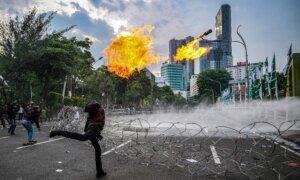South Korean Acting President Han Duck-soo described it as a ‘critical situation.’
Wildfires in South Korea have claimed the lives of at least 27 people and destroyed centuries-old Buddhist temples.
Among the dead was a helicopter pilot as he tackled a fire on Wednesday, and four firefighters who died after being trapped by a rapidly moving blaze.
The country’s acting president, Han Duck-soo, told a government response meeting, “We are nationally in a critical situation with numerous casualties because of the unprecedented rapid spread of forest fires.”
The largest of the fires began in Uiseong County in North Gyeongsang province, in the southeast of the country, and has consumed more than 81,500 acres (136 square miles)—an area more than twice the size of Manhattan.
It is the biggest single forest fire in South Korea’s history.
The previous record was a wildfire in March 2000 that destroyed 59,000 acres.
Dry weather and strong winds have caused the blazes to spread rapidly since March 21, forcing 37,000 people to be evacuated from their homes.
The government has mobilized dozens of helicopters and thousands of firefighters, but high winds have hampered efforts.
At least one of the wildfires is believed to have been triggered by sparks produced during welding work.
Senior Citizens Among Victims
Authorities said many of those who died were senior citizens who found it difficult to escape quickly. Some had reportedly refused to evacuate.
“It is worrying that many of the victims are senior citizens, including patients at nursing hospitals,” Han said, according to the Yonhap news agency.
Yonhap said President Han had also asked the Interior Minister, Ko Ki-dong, to go to North Gyeongsang province and remain there to assist with the relief effort.
Han told Ko, “Please personally take care of the victims’ health and safety on the ground and activate an efficient support system so that the wildfire-extinguishing personnel and volunteer workers do not burn out.”
Because of the region’s mountainous terrain, helicopters are required to battle the blazes.
The Ministry of the Interior and Safety says more than 120 helicopters have been deployed to help with firefighting.
Korea Forest Service chief Lim Sang-seop said the small amounts of rain forecast for Thursday would not make much difference to the conflagration.
The forest service has set its wildfire warning at its highest level, and is recommending military units pause live-fire exercises.
The fires have burned 20 of the 30 structures at the Gounsa temple complex, which is important to the Jogye Order of Korean Buddhism.
Gounsa, which was built in the 7th century and means Temple of the High Clouds in Korean, contains a pavilion-shaped building overlooking a stream.
Gounsa temple chief Deungwoon said: “The buildings and remains of what Buddhist monks have left over 1,300 years are now all gone.
“There was a wind stronger than a typhoon, and flames whipped through the air like a tornado, burning the whole area in an instant.”

As wildfires approach, a fire engine sprays water on a temple in Cheongsong, South Korea, on March 27, 2025. Ahn Young-joon/AP Photo
The wildfires are now threatening the cities of Andong and Ulsna and the neighboring counties of Uiseong and Sancheong.
On Wednesday night, strong winds forced the authorities to order the evacuation of two villages near Andong.
One of them, Puncheon, is home to the Hahoe folk village—a UNESCO World Heritage Site founded in the 14th century.
The folk village has traditional Korean houses, many with thatched roofs.
Firefighters are also trying to protect the Byeongsanseowon Confucian Academy in Andong, which dates back more than 450 years.
The Associated Press and Reuters contributed to this report.







